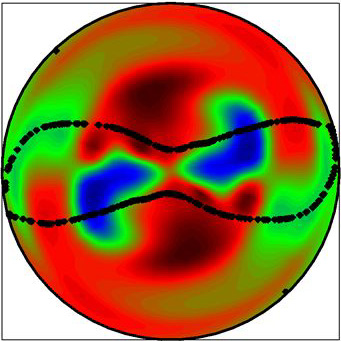Particles that Don’t Go with the Flow
Tiny particles suspended in a fluid usually remain spread out, but 15 years ago researchers found that such particles can sometimes collect into a seemingly rigid structure that moves as a unit. In the 10 June Physical Review Letters, a team uses mathematical modeling and simulation to explain the mystery. They show that such structures result from “phase locking,” where each particle moves in two perpendicular, periodic motions that become synchronized. The results suggest that such particle structures could occur in a more general class of fluid flows and could be relevant for planet formation or for future microfluidic devices.
In 1996, Dietrich Schwabe of the University of Giessen in Germany was conducting a series of experiments on so-called thermocapillary flows [1]. He placed a drop of liquid between the flat ends of two thin, vertical rods and heated the top one. When he mixed in reflective tracer particles tens of microns in size to visualize the flow–a standard technique–he was surprised that the particles accumulated into a structure made of a single filament that curved up and down throughout the fluid. The structure was stable, rotating without changing its shape. Such structures were subsequently observed in other experiments with particles of various sizes and shapes, but it wasn’t clear what forces were at play nor what features of the flow were responsible for generating them.
To study the issue, Valentina Shevtsova and colleagues from the Free University of Brussels (ULB) considered the equations that govern the motion of both the particles and the fluid in such thermocapillary flows. When they plugged these equations into numerical simulations, they found that their simulated particles spontaneously formed into structures that almost exactly mimicked the ones Schwabe observed.
To isolate the exact cause, and to see if the structures would show up in other types of flows, the team considered a common type of fluid motion for a cylindrical container, without including any details of what drives it. This motion involves two perpendicular flows. The first is a turning-over motion like that from convection, where the fluid moves upward in the center and downward toward the outer edge. The second can be represented as a ring of vortices, where each vortex turns in the opposite direction from its neighbors, and they all orbit the central axis of the cylinder. The counter-rotating vortices cause particles to weave inward and outward as they make their way around the cylinder. The team recorded the individual trajectories of each particle in their simulation.
They found that as time progressed, the fluid forces caused the particles’ motion in the two components of the flow to become synchronized, or phase locked. For example, each time a particle made one full cycle of the turnover motion, it could move one full oscillation of the weaving motion as well. If a particle got slightly out of sync, interactions with the fluid tended to push it back onto the stable trajectory, a single filament of particles wrapping around an imaginary torus and rotating around the central axis.
Now that they’ve shown that such structures can form in a general class of fluid flows, team member Mitya Pushkin thinks other researchers should be on the lookout for related effects. For example, he speculates that such a mechanism might help in planet formation, when small dust particles need to get close together to clump into larger structures. And if researchers can learn to control the structures, they may find technological relevance in microfluidic devices that are used to manipulate and transport tiny particles.
Schwabe thinks the arguments presented in the paper are sound. While he tentatively agrees that such structures could be present in a more general class of flows, he cautions that one “should not forget that noise or very small density differences in a gravity field could destroy [them].”
–Michelangelo D'Agostino
Michelangelo D’Agostino is a physicist and freelance science writer in Berkeley, California.
References
- D. Schwabe, P. Hintz, and S. Frank, “New Features of Thermocapillary Convection in Floating Zones Revealed by Tracer Particle Accumulation Structures (PAS),” Microgravity Sci. Technol. 9, 163 (1996)





